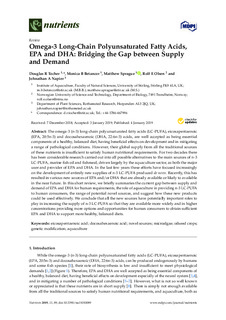| dc.contributor.author | Tocher, Douglas R. | |
| dc.contributor.author | Betancor, Mónica B. | |
| dc.contributor.author | Sprague, Matthew | |
| dc.contributor.author | Olsen, Rolf Erik | |
| dc.contributor.author | Napier, Johnathan A. | |
| dc.date.accessioned | 2019-09-24T06:50:51Z | |
| dc.date.available | 2019-09-24T06:50:51Z | |
| dc.date.created | 2019-01-17T12:23:59Z | |
| dc.date.issued | 2019 | |
| dc.identifier.citation | Nutrients. 2019, 11:89 (1), 1-20. | nb_NO |
| dc.identifier.issn | 2072-6643 | |
| dc.identifier.uri | http://hdl.handle.net/11250/2618339 | |
| dc.description.abstract | The omega-3 (n-3) long-chain polyunsaturated fatty acids (LC-PUFA), eicosapentaenoic (EPA, 20:5n-3) and docosahexaenoic (DHA, 22:6n-3) acids, are well accepted as being essential components of a healthy, balanced diet, having beneficial effects on development and in mitigating a range of pathological conditions. However, their global supply from all the traditional sources of these nutrients is insufficient to satisfy human nutritional requirements. For two decades there has been considerable research carried out into all possible alternatives to the main sources of n-3 LC-PUFA, marine fish oil and fishmeal, driven largely by the aquaculture sector, as both the major user and provider of EPA and DHA. In the last few years these efforts have focused increasingly on the development of entirely new supplies of n-3 LC-PUFA produced de novo. Recently, this has resulted in various new sources of EPA and/or DHA that are already available or likely to available in the near future. In this short review, we briefly summaries the current gap between supply and demand of EPA and DHA for human requirements, the role of aquaculture in providing n-3 LC-PUFA to human consumers, the range of potential novel sources, and suggest how these new products could be used effectively. We conclude that all the new sources have potentially important roles to play in increasing the supply of n-3 LC-PUFA so that they are available more widely and in higher concentrations providing more options and opportunities for human consumers to obtain sufficient EPA and DHA to support more healthy, balanced diets. | nb_NO |
| dc.language.iso | eng | nb_NO |
| dc.publisher | MDPI | nb_NO |
| dc.rights | Navngivelse 4.0 Internasjonal | * |
| dc.rights.uri | http://creativecommons.org/licenses/by/4.0/deed.no | * |
| dc.title | Omega-3 long-chain polyunsaturated fatty acids, EPA and DHA: Bridging the gap between supply and demand | nb_NO |
| dc.type | Journal article | nb_NO |
| dc.type | Peer reviewed | nb_NO |
| dc.description.version | publishedVersion | nb_NO |
| dc.source.pagenumber | 1-20 | nb_NO |
| dc.source.volume | 11:89 | nb_NO |
| dc.source.journal | Nutrients | nb_NO |
| dc.source.issue | 1 | nb_NO |
| dc.identifier.doi | 10.3390/nu11010089 | |
| dc.identifier.cristin | 1659237 | |
| dc.description.localcode | © 2019 by the authors. Licensee MDPI, Basel, Switzerland. This article is an open access article distributed under the terms and conditions of the Creative Commons Attribution (CC BY) license (http://creativecommons.org/licenses/by/4.0/). | nb_NO |
| cristin.unitcode | 194,66,10,0 | |
| cristin.unitname | Institutt for biologi | |
| cristin.ispublished | true | |
| cristin.fulltext | original | |
| cristin.qualitycode | 1 | |

